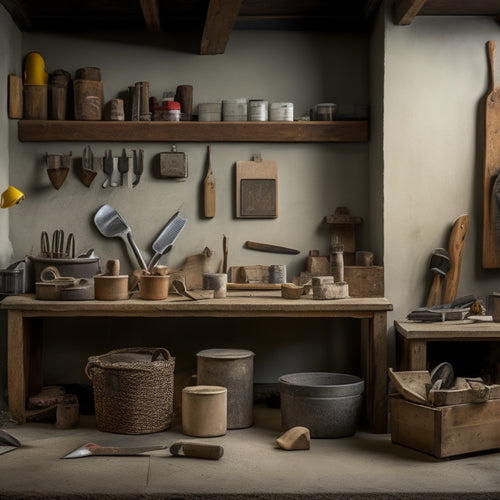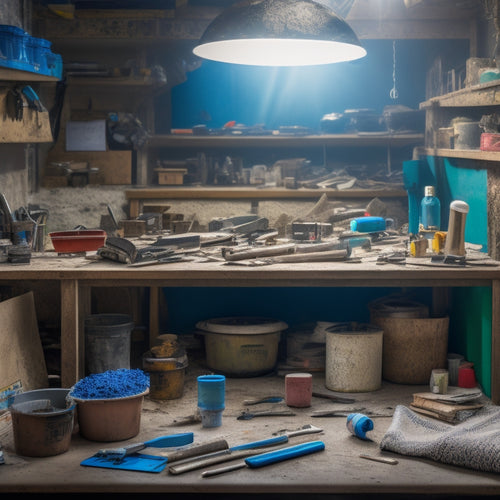
7 Best Finishing Tools to Buy Online for Renovation
Share
When it comes to achieving a flawless concrete finish in your renovation project, having the right tools is key. You'll need a combination of edgers, trowels, floats, blades, scrapers, and hand tools to get the job done. Invest in a quality power trowel with adjustable handles and the right blade material for smooth finishes. Don't forget a concrete float that suits your wall type and a set of hand tools for precision control. With the right finishing blades, you'll be able to tackle heavy-duty tasks with ease. Now that you have an idea of the essentials, uncover the specific tools and techniques that will take your renovation project to the next level.
Key Takeaways
• Evaluate edgers and trowels for achieving smooth concrete finishes, considering blade type, handle adjustability, and ergonomic design.
• Choose the right float for the job, based on blade material, handle design, and size, for efficient and high-quality results.
• Select hand tools, such as hand trowels, finishing edgers, and joint knives, that are durable, well-maintained, and suitable for the specific concrete type.
• Consider top-rated finishing blades, including diamond, silicon carbide, ceramic, and steel blades, for optimal results in various concrete finishing tasks.
• Don't forget budget-friendly scrapers, made from durable materials, for removing old adhesive, paint, or substances from concrete surfaces.
Edgers for Smooth Concrete Finish
When you're working towards a smooth concrete finish, edgers are essential tools that help you achieve a professional-looking result by removing excess concrete and creating a clean, defined edge. These tools are designed to remove excess concrete, creating a smooth shift between the concrete slab and adjacent surfaces.
By using an edger, you can guarantee a precise, clean edge that's free of imperfections. This is particularly important when it comes to concrete edging, as a well-defined edge can greatly enhance the overall appearance of the finished product.
In terms of finishing techniques, edgers play a significant role in achieving a high-quality finish. By using an edger to remove excess concrete and create a clean edge, you can then focus on applying the desired finish, whether it's a smooth, matte finish or a textured, decorative finish.
With the right edger and finishing techniques, you can achieve a professional-looking result that meets your high standards. By investing in a quality edger, you'll be well on your way to achieving a smooth, polished concrete finish that's sure to impress.
Top Rated Power Trowels Online
When selecting a power trowel for your renovation project, you'll want to evaluate two critical factors: the type of trowel blade and the adjustability of the handle.
You'll need to choose a blade that's suitable for your specific concrete finish, whether it's a smooth, textured, or stamped design.
Trowel Blade Selection
You'll need to choose the right trowel blade for your power trowel to achieve a smooth, even finish, as the wrong one can lead to uneven surfaces, wasted time, and increased costs. The right blade will depend on the type of material you're working with and the size of your power trowel.
Here's a breakdown of some common trowel blade options:
| Trowel Material | Trowel Size | Recommended Use |
|---|---|---|
| Stainless Steel | 10-12 inches | General-purpose finishing, suitable for most materials |
| Carbon Steel | 8-10 inches | Heavy-duty finishing, ideal for concrete and rough surfaces |
| Flexible Rubber | 12-14 inches | Smoothing and finishing delicate surfaces, such as drywall and plaster |
| Notched Rubber | 10-12 inches | Applying and smoothing compounds, such as joint compound and texture paste |
When selecting a trowel blade, consider the material you're working with and the size of your power trowel. Using the right blade will guarantee a smooth, even finish and help you avoid costly mistakes. Remember, a high-quality trowel blade is an investment in your renovation project's success.
Adjustable Handle Options
With the right trowel blade in hand, it's time to focus on the power trowel itself, specifically the adjustable handle options that can greatly impact your comfort and control during extended renovation projects.
As you'll be holding onto the handle for hours, it's essential to find a power trowel that offers custom handle adjustments to fit your grip and stance. Look for models with ergonomic handle designs that reduce fatigue and discomfort.
You'll want to evaluate handles with adjustable lengths, angles, and grips to accommodate your unique needs. This will enable you to maintain a comfortable stance and reduce strain on your back, shoulders, and arms.
A well-designed handle will also provide better control over the trowel, allowing you to achieve smoother finishes and more precise movements.
When shopping for a power trowel, prioritize adjustable handle options that offer a range of customization possibilities. This will guarantee that you can work efficiently and effectively, even during the most demanding renovation projects.
Best Concrete Floats for Walls
When you're working on a wall renovation project, achieving a smooth finish is essential.
You'll want to choose the right concrete float that can help you achieve this goal, and there are specific types designed specifically for walls that can make all the difference.
Smooth Finishing Results
Achieving smooth finishing results on walls relies heavily on using the right concrete floats that can effectively flatten and smooth out the surface. You want to guarantee that your surface preparation is thorough, as it sets the stage for the entire finishing process. When it comes to finishing techniques, a good concrete float can make all the difference.
Here are some key considerations to keep in mind when selecting a concrete float for smooth finishing results:
| Feature | Benefit | Impact on Finish |
|---|---|---|
| Blade Material | Durable, resistant to wear and tear | Smooth, even finish |
| Handle Design | Comfortable grip, reduced fatigue | Consistent application of pressure |
| Float Size | Covers large areas quickly, efficient | Fast, uniform finish |
Float Types for Walls
Selecting the right type of concrete float for your wall finishing project is essential, as different float designs and materials cater to specific surface requirements and desired finishes. You'll want to evaluate the type of concrete, the surface texture, and the level of finish you're aiming for.
Here are four key float types to evaluate:
-
Wood Floats: Ideal for rough, textured surfaces and for applying heavy coatings. They're often used for exterior walls and provide a more aggressive float action.
-
Resin Floats: Suitable for smooth, dense surfaces and for achieving a high-gloss finish. They're commonly used for interior walls and are more durable than wood floats.
-
Aluminum Floats: Lightweight and versatile, they're perfect for both rough and smooth surfaces. They're also easy to clean and maintain.
- Steel Floats: Heavy-duty and ideal for high-traffic areas, they're perfect for creating a smooth, even finish. They're often used for commercial projects and large-scale renovations.
When choosing a float, evaluate the float materials and float techniques required for your project. By selecting the right float, you'll achieve a professional-looking finish that meets your desired standards.
Hand Tools for Finishing Concrete
As you begin finishing concrete, you'll need a range of hand tools to achieve a smooth, even surface. Mastering concrete finishing techniques requires the right tools and proper maintenance.
A hand trowel is an essential tool for finishing concrete, and its maintenance is vital for achieving a high-quality finish. Regularly clean and store your trowel to prevent rust and guarantee it remains in good condition.
In addition to a hand trowel, you'll need a variety of other hand tools, including a finishing edger, joint knife, and float. A finishing edger is used to create a clean, defined edge, while a joint knife is used to fill and finish joints. A float is used to smooth out the concrete surface, removing any imperfections.
When selecting hand tools for finishing concrete, look for high-quality, durable options that can withstand the demands of the job. Consider the type of concrete you're working with, as well as the specific finishing techniques required, to choose the right tools for the task.
With the right hand tools and proper maintenance, you'll be able to achieve a professional-looking finish that meets your high standards.
Top Finishing Blades to Consider
You'll need to equip yourself with the right finishing blades to tackle various concrete finishing tasks efficiently. When it comes to achieving a smooth, even finish, the type of blade you use can make all the difference. Different finishing techniques require specific blade materials, so it's vital to choose the right one for the job.
Here are four top finishing blades to take into account:
-
Diamond Blades: Ideal for heavy-duty concrete cutting and grinding, diamond blades are made with industrial-grade diamonds that provide superior cutting performance and durability.
-
Silicon Carbide Blades: These blades are perfect for fine-finishing tasks, as they produce a high-gloss finish and are resistant to wear and tear.
-
Ceramic Blades: Ceramic blades are designed for high-speed cutting and are ideal for applications where a smooth finish is important, such as in decorative concrete work.
- Steel Blades: Affordable and versatile, steel blades are suitable for general-purpose concrete finishing tasks, including edging and joint cutting.
Budget-Friendly Concrete Scrapers
Concrete scrapers are an essential tool for any renovation project, and finding budget-friendly options that still deliver on performance can be a game-changer for your bottom line. You don't have to break the bank to get a quality scraper that'll help you remove old adhesive, paint, or other substances from your concrete surface.
Look for affordable scraper options made from durable materials like stainless steel or heavy-duty plastic. These materials will withstand the rigors of scraping without compromising on performance.
When choosing a budget-friendly scraper, consider the handle's comfort and grip, as well as the blade's thickness and flexibility. A scraper with a comfortable handle and a flexible blade will make the job easier and reduce fatigue.
Additionally, remember to follow essential maintenance tips to extend the life of your scraper. Regularly clean the blade and handle, and store them in a dry place to prevent rust or damage.
Essential Concrete Smoothers Found
Your renovation project demands a smooth, even finish, and that's where essential concrete smoothers come in, providing the necessary precision to refine your surface. To achieve a high-quality finish, you need to master concrete finishing techniques and effective smoothing methods. This is where the right tools come into play.
Here are the essential concrete smoothers you shouldn't miss:
-
Hand Trowels: Ideal for small areas and detail work, hand trowels provide precision control and are perfect for creating a smooth, even finish.
-
Walk-Behind Trowels: These machines are designed for larger areas and provide a high level of efficiency, making them perfect for commercial projects.
-
Power Trowels: Combining power and precision, power trowels are ideal for large areas and help you achieve a smooth finish quickly.
- Edger Trowels: Designed for working along edges and corners, edger trowels provide precision control and are essential for creating a professional-looking finish.
Frequently Asked Questions
What Safety Gear Is Necessary When Working With Concrete Finishing Tools?
When working with concrete finishing tools, you'll need essential safety gear to prevent injuries. Invest in safety equipment like gloves, safety glasses, and a dust mask to guarantee injury prevention and a safe working environment.
Can I Use Concrete Finishing Tools on Freshly Poured Concrete?
You can't use concrete finishing tools on freshly poured concrete; instead, allow it to set, then employ concrete curing methods, such as misting or covering, before applying finishing techniques, like troweling or floating, to achieve a smooth finish.
How Often Should I Maintain and Clean My Concrete Finishing Tools?
You should establish a regular maintenance schedule to clean and inspect your concrete finishing tools after each use, as this guarantees tool longevity and prevents damage, saving you time and money in the long run.
Are Concrete Finishing Tools Suitable for DIY Projects or Only Professionals?
You can successfully use concrete finishing tools for DIY projects, but be aware that professional expertise is often needed for complex tasks, and DIY suitability largely depends on the tool's complexity and your skill level.
Can I Rent Concrete Finishing Tools Instead of Buying Them Online?
You're considering renting concrete finishing tools instead of buying them online. Compare the cost of rental fees to buying tools; you'll find rental advantages, like reduced upfront costs and minimized storage needs, make sense for one-time or infrequent projects.
Conclusion
You've made it to the end of this renovation journey, and you're probably thinking, 'I've got all the tools, now it's time to get my hands dirty!'
But wait, don't rush into that concrete jungle just yet.
Take a deep breath, revisit your checklist, and make certain you've got these 7 finishing tools to guarantee a smooth, professional-looking finish.
Trust us, your walls (and your sanity) will thank you.
Related Posts
-

Why Invest in Quality Plastering Tools for Renovation
When renovating, investing in quality plastering tools is essential for achieving professional-looking results and mi...
-

3 Beginner-Friendly Tools for Plaster Renovation Success
You'll be glad to know that the three essential tools you need for a successful plaster renovation are the same ones ...
-

Get Discounted Plastering Tool Sets for DIY Renovations
You can find discounted plastering tool sets online, at local hardware stores, and thrift stores, offering a range of...


